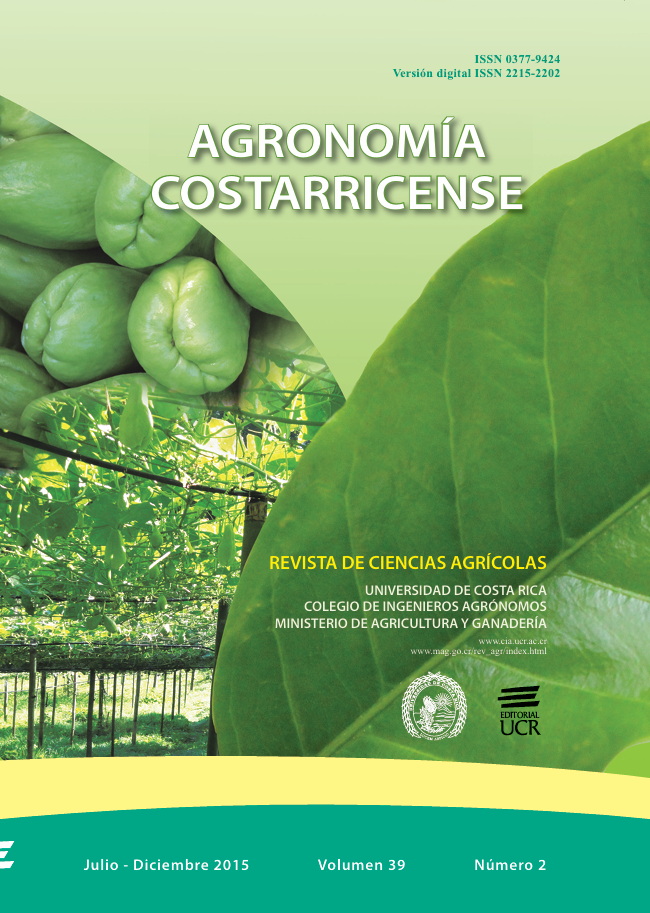Abstract
The fruit of chayote (Sechium edule (Jaqc.) Sw.) it is a vegetable of export of importance to Mexico and Costa Rica. The commercial process requires to accomplish high quality standards, which implies fruit healthy and free from defects. However, due to the high humidity conditions that develop inside the plastic packing, there have been several rejections from brokers due to the presence of fungal diseases. The aim of this work was to identify morphological (optical microscopy and scanning electron) and molecularly (PCR: Polimerase Chain Reaction) the species of the causal fungi of the main postharvest diseases of chayote fruits for export, as well as in vitro tests of the effectiveness of various commercial products as inhibitors of the growth of these fungi. The results show that Didymella bryoniae is the cause of “gummosis of cucurbits”, while Fusarium oxysporum and F. solani cause fusarium head blight or drowning of guides; these pathogens damage the basal and median part of marketable fruit, in addition to Chaetomium globosum as associate of the infectious process caused for Fusarium sp., as a non-pathogenic saprophyte. Bacillus subtilis, had an effective inhibition (0,01 mg.l-1 a.i.) in vitro tests against Didymella bryoniae, Fusarium oxysporum and F. solani. Tebuconazole-trifloxystrobin was the most effective fungicide against the first 2, with an LD50 value of 0,0116 and 0,0106 mg.l-1 respectively; not so against F. solani, where prochloraz was more effective, with a LD50 value of 0,0042 mg.l-1. These results contribute to the recognition of the most important fungal diseases in chayote and their prospects for control during the postharvest handling of fruits for export.
References
AGRIOS G.N. 2005. Plant Pathology, 3rd. ed. Academic Press, Inc.: New York. 803 p.
AUNG L.H., HARRIS C.M., RIJ R.E., BROWN J.W. 1996. Posharvest storage temperature and film wrap effects on quality of chayote, Sechium edule SW. Journal of Horticultural Sciece 71:297-304.
BARNETT H.I., HUNTER B.B. 1986. Ilustrated genera of imperfect fungi. Fourth Edition. The American Phytopathologycal Society. St. Paul, Minnesota. 218 p.
CADENA J., ARÉVALO L., AVENDAÑO C.H., SOTO M., RUIZ L.M., SANTIAGO E., ACOSTA M., CISNEROS V.M., AGUIRRE J.F. OCHOA D. 2007. Production, Genetics, Postharvest Management and Pharmacological Characteristics of Sechium edule (Jacq.) Sw. Fresh Produce, Global Science Books 1:41-52.
CADENA J., ARÉVALO L., RUIZ L., AGUIRRE J., SOTO M., LUNA M., ZAVALETA H. 2006. Quality evaluation and influence of 1-MCP on Sechium edule (Jacq.) Sw fruit during -postharvest. Postharvest Biology and Technology 40(2):170-176.
CADENA J., AVENDAÑO C.H., CISNEROS V.M., ARÉVALO M.L., AGUIRRE J.F. 2013. Modelo de Mejoramiento genético participativo en chayote (Sechium sp.). Biblioteca del Colegio de Postgraduados. 69 p.
CIBA-GEIGY. 1981. Manual para ensayos de campo en protección vegetal. 2 nd. Edition, Ciba-Geigy S.A. (Biblioteca Cátedra). Basilea, Suiza. 205 p.
DUSSEL E.P. 2008. Los costos de transporte en las exportaciones mexicanas. Vicepresidencia de Sectores y Conocimiento Sector de Integración y Comercio. 49 p. Disponible en http://idbdocs.iadb.org/wsdocs/getdocument.aspx?docnum=1802667
EPA. 2004. United States Office of Prevention, Pesticides Environmental Protection and Toxic SubstancesAgency (7505C) Pesticide Fact Sheet. Office of Pesticide ProgramsRegistration Division (7505C) US EPA Ariel Rios Building 1200 Pennsylvania Ave.Washington, DC 20460. 17 p.
FOSTER H., DRIEVER G.F., THOMPSON D.C., ADASKAVEG J.E. 2007. Postharvest decay management for stone fruit crops in California using the “reduced–risk” fungicides fludioxonil and fenhexamid. Plant Disease 91:209-215.
HERRERA E., BACAB I.M., ALEJO J.C., TUN J.M., RUIZ E. 2011. Patogenicidad de Fusarium solani (Mart.) Sacc. y Altenaria alternata (Fries) Keissler en Thevetia peruviana (Pers.) K. Schum., y su control in vitro. Fitosanidad 15(4):231-236.
JOHANSON A., BLAZQUEZ B. 1992. Fungi associated with banana crown rot on fieldpacked fruit from the Windward Islands and assessment of their sensitivity to the fungicides thiabendazole, prochloraz and imazalil. Crop Protection 11:79-83.
MESSIAEN C.M., BLANCARD D., ROUXEL F., LAFON R. 1995. Enfermedades de las hortalizas. 3a Edición. Mundi-Prensa. Madrid: España. 576 p.
SIAP. 2013. Servicio de Información Agroalimentaria y Pesquera. Consultado 2 mayo de 2013. Disponible en http://www.siap.gob.mx/index.php?option=com_wra pper&view=wrapper&Itemid=350
SIBOUNNAVONG P., SIBOUNNAVONG P., KANOKMEDHAKUL S., SOYTONG K. 2012. Antifungal activities of Chaetomium brasilense CB01 and Chaetomium cupreum CC03 against Fusarium oxysporum f.sp., lycopersici race 2. 2012. Journal of Agricultural Technology 8(3):1029-1038.
SODA M. 2000. Bacterial control of plant diseases. J. Biosci. Bioeng. 89:515-521.
SWAIN M.R., RAY R.C., NAUTIYAL C.S. 2008. Biocontrol efficacy of Bacillus subtilis strains isolated from cow dung against postharvest yam (Dioscorea rotundata L.) pathogens. Curr. Mircrobiol 57(5):407-411.
USDA. 2015. United States Department of AgricultureForeign Agricultural Service. Maximum Residue Limits (MRL) Database. Consultado 27 mayo 2015. Disponible en http://www.fas.usda.gov/maximum- residue-limits-mrl-database
UTKHEDE R. S., SHOLBERG P. L. 1986. In vitro inhibition of plant pathogens by Bacillus subtilis and Enterobacter aerogenes and in vivo control of two postharvest cherry diseases. Canadian Journal of Microbiology 32(12):963-967.
##plugins.facebook.comentarios##

This work is licensed under a Creative Commons Attribution-NonCommercial-NoDerivatives 4.0 International License.
Copyright (c) 2016 Agronomía Costarricense


